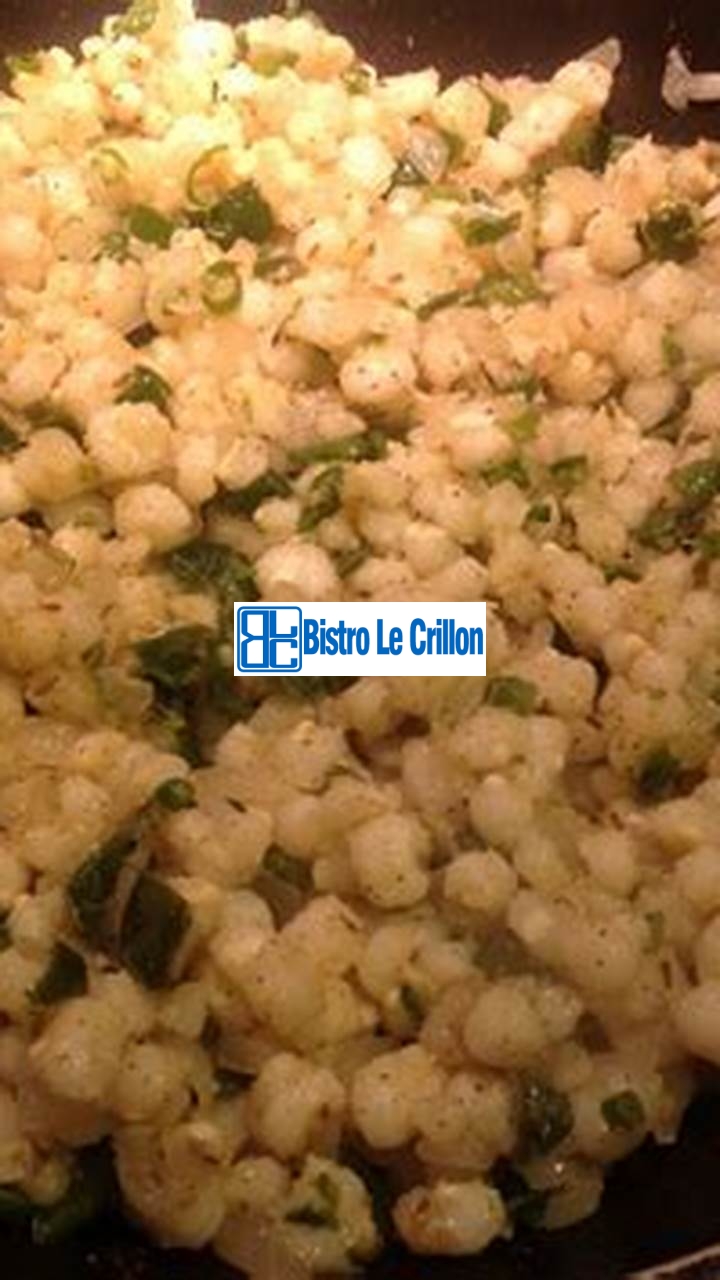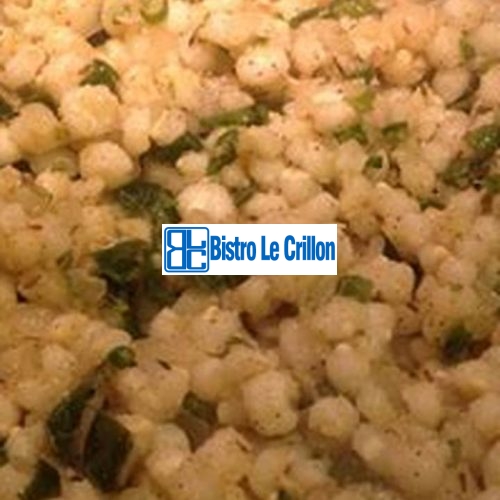Do you want to become a master in the art of cooking hominy? Look no further! With these simple tips, you’ll be able to create delicious and satisfying dishes using this versatile ingredient. Hominy, made from dried corn kernels that have been treated with an alkali solution, is a staple in many traditional cuisines across the world. Whether you’re a beginner or a seasoned cook, these tips will help you elevate your hominy dishes to a whole new level. So grab your apron, roll up your sleeves, and let’s get cooking!

Understanding Hominy: The Basics and Benefits
Discover what hominy is and the various benefits it offers in your cooking.
What is Hominy?
Hominy is a traditional Native American food that has been enjoyed for centuries. It is made from dried corn that has undergone a process called nixtamalization. This process involves soaking the dried corn in an alkaline solution, usually a mixture of water and food-grade lime. The lime helps soften the corn and remove the outer hull, resulting in large, puffy kernels known as hominy.
The size of hominy kernels can vary, with some being small and others as big as peas. They have a distinct chewy texture and a slightly nutty flavor. Hominy can be found in both yellow and white varieties, and it is a versatile ingredient used in various cuisines around the world.
Note: The word “hominy” is also used to refer to a dish that is made using hominy kernels cooked in a flavorful broth. This dish is often enjoyed as a comfort food and can be served as a side dish or as a main course.
Health Benefits of Hominy
Hominy offers several health benefits, making it a great addition to your diet:
- Rich in fiber: Hominy is an excellent source of dietary fiber, which is essential for maintaining a healthy digestive system. Fiber can help prevent constipation, promote regular bowel movements, and reduce the risk of digestive disorders.
- Packed with nutrients: Hominy is a good source of essential nutrients, such as vitamins B and E, magnesium, and phosphorus. These nutrients play a crucial role in maintaining overall health and well-being.
- Low in fat: Hominy is naturally low in fat and calories, making it a nutritious choice for those watching their weight or looking to maintain a healthy lifestyle.
- Gluten-free: Hominy is naturally gluten-free, making it a safe and healthy option for individuals with gluten intolerance or celiac disease.
Culinary Uses of Hominy
Hominy is a versatile ingredient that can be used in a variety of culinary preparations:
- Soups and stews: Hominy adds a unique texture and flavor to soups and stews. It can be used as a substitute for other grains or legumes to enhance the overall taste and nutritional value of the dish.
- Salads: Hominy can be added to salads for an extra crunch. Its mild flavor pairs well with various salad ingredients, such as fresh vegetables, herbs, and dressings.
- Tacos and enchiladas: Hominy is commonly used in Mexican cuisine, particularly in dishes like tacos and enchiladas. It can be added to fillings or used as a topping to add texture and flavor.
- Casseroles and gratins: Hominy can be incorporated into casseroles and gratins, offering a hearty and satisfying dish. Its unique texture holds up well during the cooking process.
Note: Before using hominy in your recipes, it is essential to rinse it thoroughly to remove any residual lime flavor.
In conclusion, hominy is a versatile and nutritious ingredient that can elevate the taste and texture of your dishes. It is packed with fiber, essential nutrients, and is naturally gluten-free. Whether you use it in soups, salads, or main courses, hominy is sure to impress with its unique flavor and versatility in the kitchen.
Traditional Methods of Hominy Preparation
When it comes to preparing hominy, there are various traditional methods that have been passed down through generations. These techniques ensure that the corn kernels are transformed into delicious, tender hominy that can be used in a variety of dishes.
Nixtamalization: The Ancient Method
Nixtamalization is an ancient method that originated in Mesoamerica and is still widely used today. This process involves soaking dried corn kernels in an alkaline solution, typically made by mixing water with slaked lime or wood ash. The alkaline solution helps loosen the tough outer hull of the corn and allows it to be easily removed.
Fun fact: Nixtamalization not only softens the corn but also improves its nutritional value. It increases the availability of niacin and allows the body to absorb more calcium.
After soaking the corn in the alkaline solution for several hours or overnight, it is thoroughly rinsed to remove any residue. The kernels are then cooked in fresh water until they become soft and swollen. The cooked hominy can be used immediately or stored for later use.
Soaking and Boiling: The Modern Approach
Another popular method of preparing hominy is by soaking and boiling the corn kernels. This approach is simpler and doesn’t require the use of alkaline solutions.
To start, the dried corn kernels are soaked in water for several hours or even overnight. This helps rehydrate the kernels and speeds up the cooking process. After soaking, the corn is drained and transferred to a large pot with fresh water.
⏱️ Time-saving tip: If you’re short on time, consider using a pressure cooker to cook the soaked corn. It significantly reduces the cooking time and yields tender hominy in a fraction of the time.
The corn is then brought to a boil and simmered until it becomes soft and plump. This can take anywhere from 1 to 3 hours, depending on the type and quality of the corn. Once the hominy reaches the desired consistency, it can be drained and used in various recipes.
Homemade Hominy: The DIY Process
If you’re feeling adventurous and want to try making hominy from scratch, you can embark on the DIY process. This method requires more time and effort but allows you to have full control over the quality and flavor of the hominy.
To make homemade hominy, start by selecting good-quality dried corn kernels. These can usually be found in specialty stores or online. Rinse the corn thoroughly to remove any dirt or debris.
Next, place the corn kernels in a large pot and add enough water to cover them completely. Let the corn soak for at least 24 hours, changing the water every 8 hours. This helps soften the corn and prepare it for the next step.
After the soaking period, drain the corn and transfer it to a pot filled with fresh water. Bring the water to a boil and let the corn simmer for several hours until it becomes tender. Keep an eye on the pot and add more water if necessary to prevent it from drying out.
Pro tip: You can add flavorings such as bay leaves, garlic, or onion to the pot while the corn is simmering to infuse it with extra taste.
Once the corn reaches the desired texture, drain it and let it cool before using it in your favorite hominy recipes.
In conclusion, mastering the art of cooking hominy involves understanding the traditional methods used to prepare it. Whether you choose to use the ancient nixtamalization process, the modern soaking and boiling approach, or venture into homemade hominy, these techniques will help you create delicious and versatile hominy dishes.
Choosing and Storing Hominy
Hominy, a popular ingredient in various Latin American and Southern dishes, can add a unique taste and texture to your meals. Whether you’re a seasoned cook or just starting out in the kitchen, learning how to choose and store hominy properly is essential to ensure its freshness and quality. In this article, we will guide you through the process of selecting the right hominy and storing it correctly.
Choosing the Right Hominy
When it comes to choosing the right hominy, there are a few factors to consider. First, decide whether you want to go for dried or canned hominy. Dried hominy is often considered more flavorful and can be soaked and cooked according to your preference. On the other hand, canned hominy offers convenience as it is already cooked and ready to use.
If you opt for dried hominy, make sure to check the package for any signs of moisture or damage. Avoid packages that have been torn or have a musty smell, as these can indicate poor quality or even spoilage. Additionally, look for hominy kernels that are plump and uniform in size, as this signifies that they are fresh and of good quality.
For those choosing canned hominy, inspect the cans for dents, bulges, or any signs of leakage. These could be indications of compromised quality or potential bacterial contamination. It is also advisable to check the expiration date on the can to ensure that the hominy is still within its shelf life.
Proper Storage of Hominy
After you’ve chosen the right hominy, it’s crucial to store it properly to maintain its freshness. If you have opened a can of hominy but haven’t used it all, transfer the remaining contents to an airtight container. Ensure that the container is clean and dry to prevent moisture from getting in and spoiling the hominy. Store the container in the refrigerator and consume the leftover hominy within a few days.
When it comes to storing dried hominy, ensure that you keep it in a cool, dry place, away from direct sunlight. It is best to store dried hominy in an airtight container to prevent moisture and pests from reaching it. If stored properly, dried hominy can last for several months without any compromise in quality.
Hominy Shelf Life and Expiry
The shelf life of hominy can vary depending on whether it is dried or canned. Canned hominy typically has a longer shelf life, often lasting up to 2-5 years when stored in a cool, dry place. However, it is essential to check the expiration date on the can to ensure its freshness.
On the other hand, dried hominy can last for a few months up to a year if stored correctly. Remember to check the packaging for any instructions regarding the recommended shelf life.
In conclusion, mastering the art of cooking hominy starts with choosing the right hominy and storing it properly. By selecting high-quality hominy and following proper storage techniques, you can ensure that your dishes are flavorful and delicious every time.
Hominy Recipes: Traditional and Creative Delights
If you’re looking to add some excitement to your meals, hominy is the perfect ingredient to do just that. This versatile and delicious corn product can be used in a variety of traditional and creative recipes, adding a unique and satisfying twist to your dishes.
So, let’s dive into a world of mouthwatering recipes that feature hominy as a key ingredient. Get ready to tantalize your taste buds and impress your friends and family with these flavorful creations.
Hominy Posole Soup
One of the most popular and traditional hominy recipes is Hominy Posole Soup. This hearty and comforting dish originated in Mexico and has gained popularity worldwide. It combines tender hominy with savory meat, aromatic spices, and a flavorful broth.
To make this delicious soup, start by sautéing onions and garlic in a large pot. Then, add your choice of protein, such as diced chicken or pork, and brown it lightly. Next, add hominy and a mixture of chicken broth, diced tomatoes, and spices like cumin, oregano, and chili powder. Let the soup simmer for about 30 minutes to allow the flavors to meld together.
Pro Tip: For an extra kick of flavor, top your Hominy Posole Soup with fresh cilantro, diced avocado, and a squeeze of lime juice.
New Mexican Hominy Casserole
If you’re in the mood for a hearty and cheesy dish, look no further than New Mexican Hominy Casserole. This easy-to-make recipe combines hominy with layers of cheese, green chilies, and other delicious ingredients to create a comforting and satisfying meal.
To make this casserole, start by mixing hominy with diced green chilies, diced onions, and shredded cheese. Layer the mixture in a baking dish, alternating with additional layers of cheese and chilies. Bake the casserole in the oven until the cheese is melted and bubbly, and the flavors have melded together.
Pro Tip: Serve this New Mexican Hominy Casserole with a dollop of sour cream and a sprinkle of chopped green onions for an added burst of flavors.
Hominy Salad with Lime Dressing
If you’re looking for a refreshing and healthy dish that showcases hominy’s versatility, try making a Hominy Salad with Lime Dressing. This vibrant and tangy salad is perfect for hot summer days or as a light side dish.
To make this salad, start by combining hominy with fresh vegetables like tomatoes, cucumbers, and bell peppers. Toss the mixture with a zesty lime dressing made from freshly squeezed lime juice, olive oil, honey, and a pinch of salt. Chill the salad in the refrigerator for at least an hour to allow the flavors to meld together.
Pro Tip: Add some diced avocado and crumbled feta cheese to your Hominy Salad with Lime Dressing for extra creaminess and tanginess.
Now that you have discovered these tantalizing hominy recipes, you can add a unique and flavorful twist to your meals. Whether you choose to make the traditional Hominy Posole Soup or explore the creative flavors of the New Mexican Hominy Casserole and Hominy Salad with Lime Dressing, you are sure to impress your taste buds and everyone around your dining table. Happy cooking!
Hominy in Different Cuisines: A Global Perspective
Discover how hominy is used in diverse world cuisines and the unique dishes it creates.
Hoppin’ John: Southern American Dish
Hoppin’ John is a classic Southern American dish that incorporates hominy as one of its main ingredients. With a rich history rooted in African and Caribbean traditions, Hoppin’ John is a flavorful and hearty dish that is often served on New Year’s Day to bring good luck and prosperity for the coming year. The dish typically consists of black-eyed peas, rice, onions, and various seasonings, with hominy adding a unique texture and taste.
- Hoppin’ John is traditionally prepared by cooking the black-eyed peas and hominy together until tender.
- The rice is cooked separately, and then both components are mixed together with sautéed onions and spices.
- The result is a delicious and satisfying meal that showcases the versatility of hominy in Southern American cuisine.
✨ Fun Fact: In some versions of Hoppin’ John, a coin or trinket is hidden within the dish, and whoever finds it is said to receive extra luck and blessings!
Pozole: Mexican Stew
Pozole is a traditional Mexican stew that features hominy as a key ingredient. This flavorful dish has deep roots in Mexican culinary culture and is often enjoyed during celebrations and special occasions. The stew typically consists of pork or chicken, hominy, and a variety of spices and seasonings. It is traditionally garnished with shredded cabbage, radishes, lime juice, and served with corn tortillas.
️ Pro Tip: For an extra kick of heat, add some diced jalapeños or a dash of hot sauce to your pozole!
The process of preparing pozole involves simmering the meat with onions, garlic, and spices until tender. Once the meat is cooked, the hominy is added, and the stew is allowed to simmer further to develop its rich flavors. The result is a comforting and satisfying dish that showcases the versatility of hominy in Mexican cuisine.
Piki: Hopi Blue Corn Hominy Dough
Piki is a traditional Hopi dish made from Hopi blue corn hominy dough. This unique and culturally significant food is often enjoyed during special occasions and ceremonies. Piki is a thin, delicate bread that is cooked on hot stones and rolled into cylinders or cones. It has a distinct flavor and texture that is both earthy and nutty, making it a true delicacy.
- The process of making piki involves grinding the dried blue corn hominy into a fine flour.
- The flour is then mixed with water and various seasonings to form a thin batter.
- The batter is carefully spread onto hot stones and cooked until it becomes thin and crispy.
- Once cooked, the bread is rolled into shapes and served alongside other Hopi dishes.
Did you know? Hominy is made by soaking dried corn kernels in an alkali solution, which helps remove the hulls and germ, resulting in larger and softer grains.
Piki is a true testament to the culinary artistry of the Hopi people and showcases how hominy can be transformed into a unique and delicious dish.
In conclusion, hominy is a versatile ingredient that plays a significant role in various cuisines around the world. Whether it’s used in hearty Southern American dishes like Hoppin’ John, flavorful Mexican stews like pozole, or culturally significant Hopi bread like piki, hominy adds a distinct texture and taste that elevates these dishes to new heights. So, why not explore the world of hominy and master the art of cooking with this delicious ingredient?
Thank you for reading our article on how to cook hominy. We hope you found the information helpful and that it inspires you to try this delicious ingredient in your own kitchen. Have fun experimenting with different recipes and techniques to elevate your dishes. Remember, cooking is all about exploring and discovering new flavors, so don’t be afraid to get creative. If you have any questions or suggestions, please feel free to leave a comment below. We appreciate your support and hope to see you again soon!
Frequently Asked Questions
Here are some frequently asked questions about cooking hominy:
| No. | Questions | Answers |
|---|---|---|
| 1. | What is hominy? | Hominy is a type of dried corn that has been treated with an alkali solution to remove the outer hulls. This process, known as nixtamalization, gives hominy its distinctive flavor and texture. |
| 2. | How do you cook hominy? | To cook hominy, first, rinse it under cold water to remove any debris. Then, add it to a pot and cover it with water or broth. Bring the liquid to a boil and then reduce the heat to a simmer. Cook the hominy for about 1-2 hours, or until it is tender. Drain any excess liquid before using or serving. |
| 3. | Can you eat hominy raw? | No, hominy should not be eaten raw. It needs to be cooked before consuming to soften the kernels and make them safe to eat. |
| 4. | What dishes can you make with hominy? | Hominy is a versatile ingredient that can be used in a variety of dishes. It is commonly used in Mexican cuisine to make dishes like pozole and menudo. It can also be added to stews, soups, salads, and even used as a base for breakfast bowls. |
| 5. | Where can I buy hominy? | Hominy can usually be found in the canned goods section of most grocery stores. You can also find it online or in specialty stores that carry Latin American or Mexican ingredients. |
| 6. | Can I freeze cooked hominy? | Yes, you can freeze cooked hominy. Allow it to cool completely before transferring it to a freezer-safe container. It can be stored in the freezer for up to three months. Thaw it in the refrigerator before using. |
Closing Thoughts
We hope this article has provided you with valuable insights into cooking hominy. Now that you have learned the basics, it’s time to get creative in the kitchen. Whether you decide to make a comforting pozole or add hominy to your favorite stew, we’re sure you’ll enjoy the unique flavor and texture it brings to your dishes. Remember to experiment and have fun with your culinary creations. Thank you for reading, and we look forward to having you visit again soon for more exciting recipes and cooking tips. Happy cooking!

Hominy Recipe
Ingredients
- 2 cups hominy
- 4 cups water or broth
Instructions
- Rinse the hominy under cold water to remove any debris.
- In a pot, add the hominy and cover it with water or broth. Bring to a boil, then reduce heat to a simmer. Cook for 1-2 hours, or until tender. Drain before using or serving.






